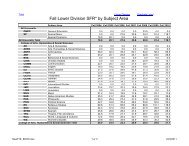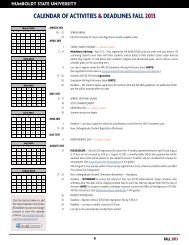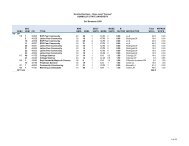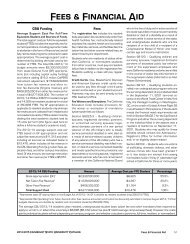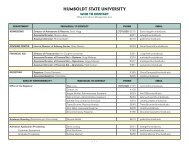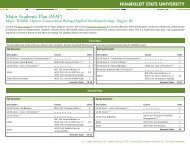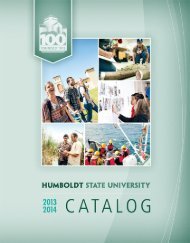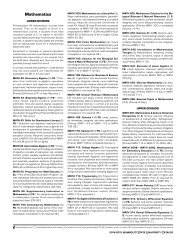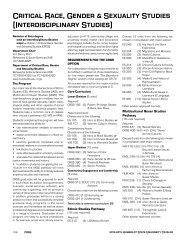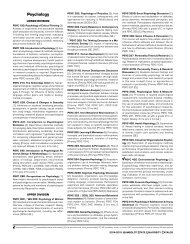2007-08 Academic Year - Humboldt State University
2007-08 Academic Year - Humboldt State University
2007-08 Academic Year - Humboldt State University
Create successful ePaper yourself
Turn your PDF publications into a flip-book with our unique Google optimized e-Paper software.
esearch training, data collection and analysis.<br />
[Rep.]<br />
ANTH 690. Thesis (1-4). [Rep.]<br />
ANTH 691. Master’s Comprehensive Exams<br />
(1-4). [Rep].<br />
ANTH 695. Field Research (1-4). Supervised field<br />
research. [Rep.]<br />
ANTH 699. Independent Study (1-4). Directed<br />
study of selected problems, issues, and theoretical/analytical<br />
concerns. ]Rep.]<br />
Art<br />
LOWER DIVISION<br />
ART 103. Introduction to Art History (3). Survey<br />
of Western art from prehistoric times to the<br />
modern period. [GE.]<br />
ART 104B. Ancient Art (3). Prehistoric, Mesopotamian,<br />
Egyptian, Aegean, Greek, and Roman<br />
art. [GE.]<br />
ART 104C. Medieval Art (3). Early Christian,<br />
Byzantine, early medieval, Romanesque, and<br />
Gothic art. [GE.]<br />
ART 104F. Renaissance Art (3). Italian and<br />
Northern European artists during the Renaissance.<br />
[GE.]<br />
ART 104G. Baroque Art (3). Rubens, Rembrandt,<br />
and other artists, 1600-1750. [GE.]<br />
ART 104H. 19th Century Art (3). European art<br />
from the neoclassical to the post-impressionist<br />
periods. [GE.]<br />
ART 104i. 20th Century Art (3). Survey of painting<br />
and sculpture in the 20th century. [GE.]<br />
ART 104J. American Art (3). Survey of art<br />
covering major artists, stylistic movements, and<br />
cultural trends within the borders of the US from<br />
the Colonial Period to WWII. [DCG-d. GE.]<br />
ART 104K. Introduction to Tribal Art (3). African,<br />
Native American, and Oceanic art. Various<br />
approaches to, and concepts of, art in these<br />
cultural regions. [DCG-n. GE.]<br />
ART 104M. Latin American Art (3). History of<br />
art in Mexico, Central and South America, the Caribbean.<br />
Emphasis on modern, post-independence<br />
period. Consider social, political, and cultural contexts<br />
in which art was produced. [DCG-n. GE.]<br />
ART 104N. Asian Art (3). Surveys the visual arts<br />
of India, China, and Japan in the context of each<br />
country’s diverse religious, cultural and political<br />
histories. [DCG-n. GE.]<br />
ART 105B. Beginning Drawing (3). Training in<br />
fundamentals of drawing: form, space, organization,<br />
composition. Various drawing materials<br />
and techniques. [CAN ART 8. GE.]<br />
ART 105C. Color and Design (3). Concepts of<br />
line, texture, value, shape, color, and composition<br />
in context of 2-dimensional space. Visual perception;<br />
illusions; cultural influences on the way we<br />
see. Studio format. [GE.]<br />
ART 106. Beginning Painting (3). Tools in painting:<br />
color, composition, and fundamental technical<br />
issues. Develop visual principles through various<br />
subject matter. Strongly recommended: ART<br />
105B completed before enrolling. [CAN ART<br />
10. GE.]<br />
ART 107. Printmaking I (3). Introduction to<br />
contemporary practices and aesthetics of<br />
printmaking. Formal elements and techniques<br />
using a broad range of materials and processes<br />
including: relief (linocut, woodcut), itaglio (drypoint,<br />
etching), lithography, and monoprinting. Strongly<br />
recommended: ART 105B or 105C completed<br />
before enrolling. [GE.]<br />
ART 1<strong>08</strong>. Beginning Graphic Design (3). An<br />
introduction to graphic design covering design,<br />
color and form and their influence on multimedia<br />
design applications. The applications Photoshop,<br />
Illustrator, and InDesign will be introduced. [GE.]<br />
ART 109. Beginning Sculpture (3). Introduction<br />
to sculpture and three-dimensional thinking and<br />
vocabulary. Students learn techniques such as, additive<br />
and reductive methods, mold making, found<br />
object construction, etc. Presentation of correct<br />
tool usage and safety issues. Studio practice,<br />
research, class discussions, slide lectures, field<br />
trips, and critique. [CAN ART 12. GE.]<br />
ART 112. Scientific Drawing I (3). This course<br />
develops the ability to accurately draw and illustrate<br />
technical and scientific information.<br />
Adapted to needs of science students as well as<br />
art students. [CAN ART 8]<br />
ART 122. Life Drawing I (3). Study form and<br />
composition from the human figure. [Rep once.<br />
Prereq: ART 105B or IA.]<br />
ART 250. Beginning Photography (3). Fundamentals<br />
of fine art black-and-white photography<br />
as medium of personal expression. Camera<br />
operations; exposure, development, and printing<br />
controls; professional presentation methods.<br />
Discuss work of historical and contemporary fine<br />
art photographers. [CAN ART 18]<br />
ART 280. Beginning Jewelry (3). Introduction<br />
to fabrication in silver and base metals through<br />
assigned projects. Techniques: sawing, soldering,<br />
etching, stone setting. Proper tool usage and<br />
safety. Problem solving and development of intuitive<br />
thinking. Slides, research, and critiques.<br />
ART 290. Beginning Ceramics (3). Assigned<br />
projects to develop basic forming and glazing<br />
skills, an understanding of visual form, and creative<br />
problem solving. [CAN ART 6]<br />
UPPER DIVISION<br />
ART 300. Major Monuments of Art (3). Monuments<br />
through the ages explored in social/<br />
historical context, from the Parthenon to Picasso’s<br />
Guernica, from St. Peters in the Vatican to<br />
Monet’s Waterlilies. [GE.]<br />
ART 301. The Artist (3). Function and role of the<br />
artist from an historical perspective. Art studied<br />
through the artist in various historical periods.<br />
[Rep. GE.]<br />
ART 310. Topics in Aegean, Greek & Roman Art<br />
(4). Specific questions within the period. One of<br />
four units is individualized instruction on assigned<br />
topics. [Rep as topics change.]<br />
ART 311. Topics in Early Christian, Byzantine<br />
& Medieval Art (4). Specific questions within the<br />
period. One of four units is individualized instruction<br />
on assigned topics. [Rep as topics change.]<br />
ART 312. Topics in Italian Renaissance Art (4).<br />
Specific questions within the period. One of four<br />
units is individualized instruction on assigned topics.<br />
[Rep as topics change.]<br />
ART 313. Topics in Northern Renaissance Art<br />
(4). Specific questions within the period. One of<br />
four units is individualized instruction on assigned<br />
topics. [Rep as topics change.]<br />
ART 314. Topics in Baroque & Rococo Art (4).<br />
Specific questions within the period. One of four<br />
units is individualized instruction on assigned topics.<br />
[Rep as topics change.]<br />
ART 315. Topics in 19th Century Art (4). Specific<br />
questions within the period. One of four units<br />
is individualized instruction on assigned topics.<br />
[Rep as topics change.]<br />
ART 316. Topics in Early 20th Century Art (4).<br />
One of four units is individualized instruction on<br />
assigned topics. [Rep as topics change.]<br />
ART 317. Topics in Late Modern & Contemporary<br />
Art (4). Art since mid-20th century. Variable<br />
emphasis. One of four units is individualized<br />
instruction on assigned topics. [Rep as topics<br />
change.]<br />
ART 318. Topics in the History of Photography<br />
(4). Development of photography as an aesthetic<br />
medium. Major photographers and their ideas<br />
and contributions in the context of art history.<br />
Alternating courses cover 19th, 20th centuries.<br />
One of four units is individualized instruction on<br />
assigned topics. [Rep as topic changes.]<br />
ART 319. Contemporary Art & Theory (4).<br />
This course explores global contemporary art<br />
and theory (post 1985). Emphasis is placed on<br />
understanding major trends as well as theoretical<br />
models so that students can generate their own<br />
informed analysis. [Prereq: ART 104i. DCG-d.]<br />
ART 321. Intermediate Drawing (3). [Prereq:<br />
ART 105B or IA. Rep.]<br />
ART 323. Scientific Drawing II (3). Further develops<br />
the ability to accurately draw and illustrate<br />
technical and scientific information. Adapted to<br />
needs of science students as well as art students.<br />
[Prereq: ART 112 or IA. Rep.]<br />
ART 324. Advanced Drawing (3). Explore individual<br />
intuition and vision; expand fundamentals<br />
gained in Prereq: courses. [Prereq: ART 122 or<br />
321 or 323, or IA. Rep.]<br />
ART 325. Life Drawing II (3). Continue exploring<br />
figure drawing, emphasizing formal aspects of<br />
individual vision with use of color, mixed media, and<br />
abstraction. [Prereq: ART 122 or IA. Rep. ]<br />
ART 326. Intermediate Painting (3). Further develop<br />
foundation of painting: materials, techniques,<br />
form, space, organization, composition, color.<br />
Explore individual intuition and vision. Emphasis<br />
on visual form and principles rather than subject<br />
matter. [Prereq: ART 106 or IA. Rep.]<br />
DCG diversity & common ground; d domestic, n non-domestic; disc discussion; F fall, S spring, Su summer; GE general ed; IA instructor approval; lect lecture; prereq prerequisite; rep repeatable<br />
<strong>2007</strong>-20<strong>08</strong> <strong>Humboldt</strong> <strong>State</strong> <strong>University</strong> Catalog Art<br />
191



